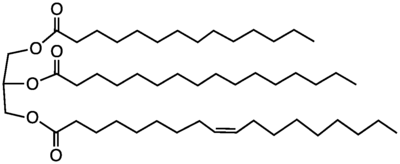Butterfat
Butterfat or milkfat is the fatty portion of milk. Milk and cream are often sold according to the amount of butterfat they contain.
Composition

Butterfat is mainly composed of triglycerides. Each triglyceride contains three fatty acids. Butterfat triglycerides contain the following amounts of fatty acids (by mass fraction):[1][2][3]
Butterfat contains about 3% trans fat, which is slightly less than 0.5 grams per US tablespoon.[3] Trans fats occur naturally in meat and milk from ruminants. The predominant kind of trans fat found in milk is vaccenic acid. Trans fats may be also found in some industrially produced foods, such as shortenings obtained by hydrogenation of vegetable oils. In light of recognized scientific evidence, nutritional authorities consider all trans fats equally harmful for health and recommend that their consumption be reduced to trace amounts.[4][5][6][7][8] However, two Canadian studies have shown that vaccenic acid could be beneficial compared to vegetable shortenings containing trans fats, or a mixture of pork lard and soy fat, by lowering total LDL and triglyceride levels.[9][10][11][12][13] A study by the US Department of Agriculture showed that vaccenic acid raises both HDL and LDL cholesterol, whereas industrial trans fats only raise LDL with no beneficial effect on HDL.[14]
U.S. standards
In the U.S., there are federal standards[15] for butterfat content of dairy products.[16][17][18][19] Many other countries also have standards for minimum fat levels in dairy products. Commercial products generally contain the minimum legal amount of fat with any excess being removed to make cream, a valuable commodity.
- Milks
- Non-fat milk, also labeled "fat-free milk" or "skim milk", contains less than 0.5% fat
- Low-fat milk is 1% fat
- Reduced-fat milk is 2% fat
- Whole milk contains at least 3.25% fat
- Cheeses
- Dry curd and nonfat cottage cheese contain less than 0.5% fat
- Lowfat cottage cheese contains 0.5–2% fat
- Cottage cheese contains at least 4% fat
- Swiss cheese contains at least 43% fat relative to the total solids
- Cheddar cheese contains at least 50% fat relative to the total solids
- Frozen desserts
- sherbet contains 1–2% fat
- Lowfat ice cream, also called ice milk, contains no more than 2.6% fat
- Ice cream contains at least 10% fat
- Frozen custard, like ice cream, contains at least 10% fat, but it also must contain at least 1.4% egg yolk solids
- Creams
- Half and half contains 10.5–18% fat
- Light cream and sour cream contain 18–30% fat
- Light whipping cream (often called simply "whipping cream") contains 30–36% fat
- Heavy cream contains a minimum of 36% fat
- Manufacturer's cream (not federally regulated) contains 40% fat
- Butter (including whipped butter) contains at least 80% fat
References
- National Research Council, 1976, online edition Fat Content and Composition of Animal Products, Printing and Publishing Office, National Academy of Science, Washington, D.C., ISBN 0-309-02440-4; p. 203
- The quote values vary by 1–3% according to the source: Jost, Rolf (2007). "Milk and Dairy Products". Ullmann's Encyclopedia of Industrial Chemistry. doi:10.1002/14356007.a16_589.pub3. ISBN 978-3527306732.
- "National Nutrient Database for Standard Reference Release 28". United States Department of Agriculture.
- EFSA Panel on Dietetic Products, Nutrition, and Allergies (NDA) (2010). "Scientific opinion on dietary reference values for fats". EFSA Journal. 8 (3): 1461. doi:10.2903/j.efsa.2010.1461.CS1 maint: multiple names: authors list (link)
- UK Scientific Advisory Committee on Nutrition (2007). "Update on trans fatty acids and health, Position Statement" (PDF). Archived from the original (PDF) on 10 December 2010.
- Brouwer IA, Wanders AJ, Katan MB (2010). "Effect of animal and industrial trans fatty acids on HDL and LDL cholesterol levels in humans – a quantitative review". PLOS ONE. 5 (3): e9434. Bibcode:2010PLoSO...5.9434B. doi:10.1371/journal.pone.0009434. PMC 2830458. PMID 20209147. S2CID 983576.
- "Trans fat". It's your health. Health Canada. Dec 2007. Archived from the original on 20 April 2012.
- "EFSA sets European dietary reference values for nutrient intakes" (Press release). European Food Safety Authority. 26 March 2010.
- Trans Fats From Ruminant Animals May Be Beneficial – Health News. redOrbit (8 September 2011). Retrieved 22 January 2013.
- Bassett, C. M. C.; Edel, A. L.; Patenaude, A. F.; McCullough, R. S.; Blackwood, D. P.; Chouinard, P. Y.; Paquin, P.; Lamarche, B.; Pierce, G. N. (Jan 2010). "Dietary Vaccenic Acid Has Antiatherogenic Effects in LDLr-/- Mice". The Journal of Nutrition. 140 (1): 18–24. doi:10.3945/jn.109.105163. PMID 19923390.
- Wang, Flora & Proctor, Spencer (2 April 2008). "Natural trans fats have health benefits, University of Alberta study shows" (Press release). University of Alberta.
- Wang Y, Jacome-Sosa MM, Vine DF, Proctor SD (20 May 2010). "Beneficial effects of vaccenic acid on postprandial lipid metabolism and dyslipidemia: Impact of natural trans-fats to improve CVD risk". Lipid Technology. 22 (5): 103–106. doi:10.1002/lite.201000016.
- Bassett C, Edel AL, Patenaude AF, McCullough RS, Blackwood DP, Chouinard PY, Paquin P, Lamarche B, Pierce GN (2010). "Dietary Vaccenic Acid Has Antiatherogenic Effects in LDLr−/− Mice". The Journal of Nutrition. 140 (1): 18–24. doi:10.3945/jn.109.105163. PMID 19923390.
- David J. Baer, PhD. US Department of Agriculture, Agricultural Research Service, Beltsville Human Nutrition Research Laboratory. New Findings on Dairy Trans Fat and Heart Disease Risk, IDF World Dairy Summit 2010, 8–11 November 2010. Auckland, New Zealand
- United States Department of Agriculture Agricultural Marketing Service
- USDA Commercial Item Description: Fluid Milk and Milk Products (2018) Accessed January 29, 2020
- USDA Specifications for Cream Cheese, Cream Cheese with other Foods, and Related Products (1994).
- United States Department of Agriculture Standard for Ice Cream (1977).
- USDA Commercial Item Description: Cream, Eggnog, Half-and-half, and Sour Cream (2002).